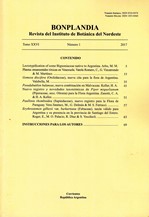Toxic ornamental plants in Venezuela
DOI:
https://doi.org/10.30972/bon.2612073Palavras-chave:
Biodiversity, economic botany, ornamental plant, toxic plant, VenezuelaResumo
The aim of this research was to contribute information on toxic ornamental plants in Venezuela. Information on taxonomy, common names, habit, origin, status, location, propagation and toxicology (part of the plant, effects) was compiled from articles, books, catalogs, herbarium collections. A botanical analysis (taxonomy, common names, habit, origin, status, location, propagation) and toxicology (part of the plant, effects) was performed. The information about plant poisoning cases was requested to SIMET (Pharmacy faculty -UCV). Seventy-eight species were found in 34 families, the most important were: Apocynaceae (10 genera/12 species), Araceae (9/9), Euphorbiaceae (4/10) and Solanaceae (5/6). Genus Euphorbia was the most species rich. Most species were exotic species (79.5%) and shrubs (32.1%). The entire plant (35) and latex (19) were the most toxic parts and the most frequent accidental ingestion (61.5%). Twenty cases were reported between 2009-2013, of which 80% were minors, female and urban areas. There is very little information published in Hispanic American countries
Downloads
Downloads
Publicado
Como Citar
Edição
Seção
Licença
Declaration of Adhesion to Open Access
- All contents of Bonplandia journal are available online, open to all and for free, before they are printed.
Copyright Notice
- Bonplandia magazine allows authors to retain their copyright without restrictions.
- The journal is under a Creative Commons Attribution 4.0 International license.















.jpg)


